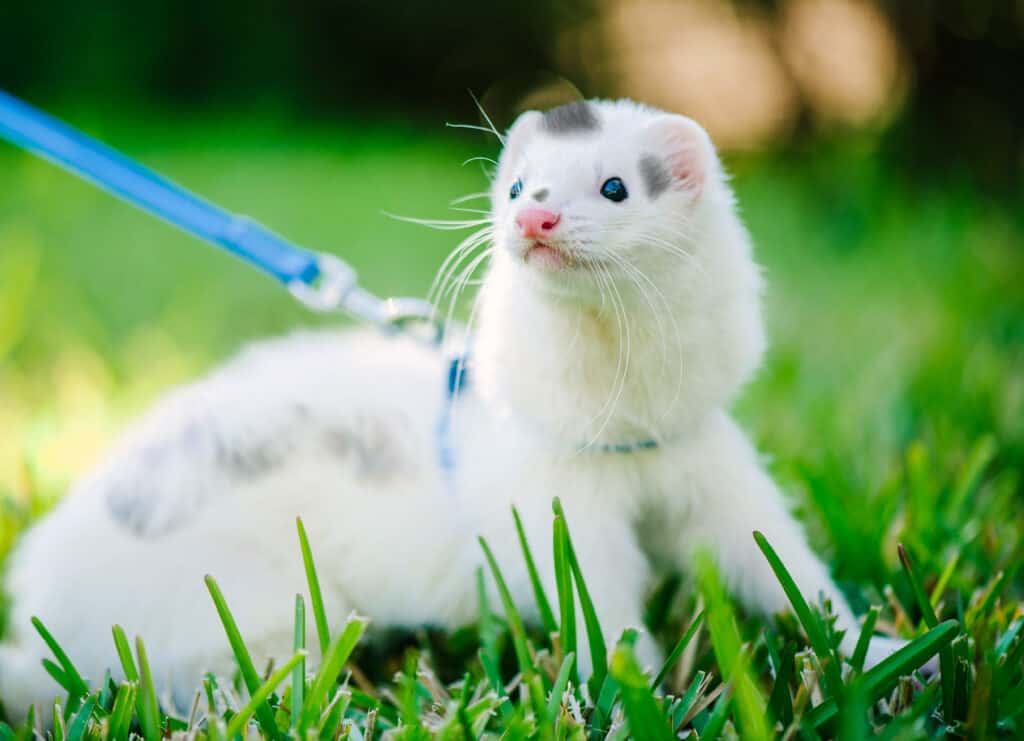4 Cheapest Ferrets To Have as Pets
Thinking of bringing home a ferret but not sure you can afford it? Check out these four cheapest ferrets to bring home and how to find them. You could decide having one of these adorable critters is well within your grasp after all.
Types of Ferrets

©Julie Gaia/Shutterstock.com
Typically, you’ll find ferrets are divided by their base coat color. Many have a mixture of two or more colors, while some have a single shade. These happy little critters may also be categorized by size or body length.
The patterns and colors include:
- Albino
- Sable
- Regular Sable
- Regular Sable Mitts
- Black sable
- Black Sable Mitts
- Blaze
- Dalmatian
- Silvertips
- Champagne
- Chocolate Mitts
- Chocolate
- Siamese
- Siamese Mitts
- Cinnamon
- Cinnamon Mitts
- Heavy Silver or Pewter
- Panda
- Light pattern
- Medium pattern
- Striped White
- Dark-eyed White (DEW)
What are the Cheapest Ferrets?

©iStock.com/GlobalP
The best way to find an affordable ferret is going to start with preventing yourself from being too picky about their looks. Certain ferret colors and types of ferrets are significantly more costly than others.
So, if you’re looking for the cheapest ferrets, expect to find them as: white albino ferrets and sable ferrets (not black sable). You’ll generally find these at less for around $50 each, unless you go to a high-end breeder.
Generally speaking, the other types of ferrets will cost significantly more, including the chocolate, cinnamon, champagne, white, black, and silvertips. These could cost you upward of $150 or more.
If you’re really set on finding a non-albino or sable ferret, though, hit up the pet rescues to see if any can be found there. These will cost a modest adoption or rehoming fee and that’s it, apart from normal care costs.
You may also find free to low-cost ferrets on sites like PetFinder, Craigslist, Freecycle, and others when folks realize they are allergic, can’t care for them, or simply need to rehome them. These can be tricky, though, as not all sellers or givers are honest about the animals. The critters could have an undisclosed health problem the original owner skips sharing to ensure someone else takes the animal.
How to Care for the Cheapest Ferrets

©Eric Isselee/Shutterstock.com
Caring for your ferrets doesn’t have to be heard, but there are some requirements that should be considered before bringing one or more home.
Provide Them With Appropriate Housing
Keep your ferret in an appropriate cage that has enough room for them to scamper about freely. The highly energetic animals need fresh, clean bedding, toys, climbing options, and dark places where they can hide away.
Feed Them a Healthy, Nutritious Diet
Make sure your ferret has a proper diet, not just the cheapest food you can afford. This food should be high-quality and specifically designed for ferrets. Make sure they have plenty of water at their disposal as well.
Provide Them With Plenty of Regular Exercise
To help keep your ferret healthy and happy, you’ll need to provide them with plenty of exercise. Give them toys and tunnels, caves, and things to crawl in, around, through, and under to keep them active.
Offer Them Regular Veterinary Care
Be sure to bring your ferret into the veterinarian fairly often for check-ups and vaccines. This helps keep your animal healthy but also helps prevent worse health conditions down the road that can wind up quite costly to treat.
Which is Better – Female or Male Ferrets?

©Liliana_Cantu/Shutterstock.com
Both male and female ferrets are known for their antics and rowdy behavior. The females is naturally smaller and lighter than a male. They’re both affectionate and cuddly and both love their people. So, the reality is, it really comes down to preference. Females still need the same size space for living and as much exercise and playtime as their male counterparts. So, pick the ferret you fall in love with and don’t base it on gender. If you opt to keep both males and females together, though, either anticipate some babies or get them spayed and neutered. It’s also particularly important for females to be spayed as they can suffer from a disease known as Aplastic Anemia if they don’t mate by the end of their heat cycles. It’s best to get females spayed by 9 months of age.









